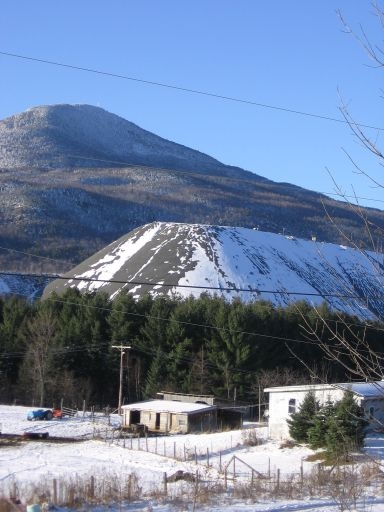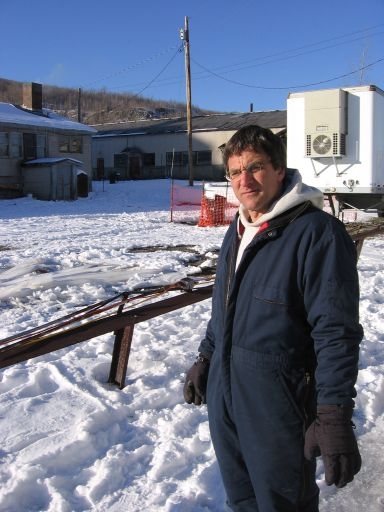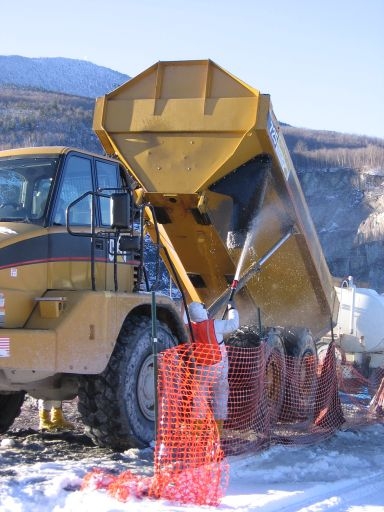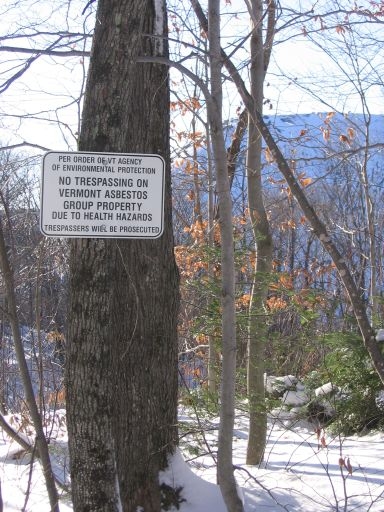 (Host) Vermont’s largest hazardous waste site is located on a remote mountainside in northern Lamoille County.
(Host) Vermont’s largest hazardous waste site is located on a remote mountainside in northern Lamoille County.
For almost a century, workers mined asbestos from Belvidere Mountain, leaving behind 70 million tons of rock waste.
Asbestos fibers from the waste are washing into the headwaters of the Lamoille and Missisquoi Rivers.
So this fall, the U.S. Environmental Protection Agency launched a $2 million project to stabilize the site.
As VPR’s John Dillon reports, that’s just the beginning.
(Sounds of powerwash, generators and high pressure hoses)
(Dillon) The workers wear white moon suits with respirators as they hose off the mud-caked equipment.
They need to carefully clean anything that’s been exposed to the tailings from the asbestos mine.
If the fibers are inhaled over time, they can cause lung cancer. So even the respirators and moon suits have to be disposed of as hazardous waste.
(Lipson) "Every site has its unique characteristics but just the volume of material here – it’s pretty overwhelming."
(Dillon) Gary Lipson is the coordinator on the site for the Environmental Protection Agency.
The EPA is spending $2 million to stop asbestos waste from flowing into nearby wetlands and streams now. A complete cleanup could cost $500 million.
Outside the EPA’s work trailer, Lipson points out one spot where the agency focused its efforts.
(Lipson) "One of the priorities after speaking with the state when EPA first got involved was trying to protect what’s known as a fire pond right here. The towns used this to pull water out and fight fires if they need to. This was in danger of getting overrun by sediment that’s coming down from this large peak we see in front of us here. The sediment was collecting and we thought that one more season of snow melt would carry that sediment right into the water."
(Dillon) The large peak Lipson is talking about is 500 feet tall. It’s one of two immense piles of waste that tower over the landscape.
 The EPA says eight wetlands suffer from asbestos sediment that run off the site. The muddy material smothers the bugs and other organisms that make up the base of the aquatic food chain.
The EPA says eight wetlands suffer from asbestos sediment that run off the site. The muddy material smothers the bugs and other organisms that make up the base of the aquatic food chain.
And because Belvidere Mountain straddles the divide between the Missisquoi and Lamoille River watersheds, the asbestos waste has the potential to wash into two major rivers that flow into Lake Champlain.
The EPA classifies all forms of asbestos as a carcinogen. But some research suggests that the mineral mined here – it’s known as chrysotile, or white asbestos – is less dangerous than other forms which are more easily absorbed into the lungs.
(Lipson) "But there’s been very little scientific data .. in the way of health studies done at this site or the surrounding area. So we don’t have a lot of health data to look back on and see if this was indeed a problem above normal for the employees who have been here for the last 100 years."
(Dillon) John Schmeltzer is an environmental analyst with the state Department of Environmental Conservation. He says the health department has looked at the cancer registry – a public health data base – and has not found elevated asbestos-related cancer in the area.
Schmeltzer says officials are doing more research on the possible health effects. But right now, he says the main challenge is the sheer size of the site.
(Schmeltzer) "This mine site has a approximately – I know the estimated volume is 72 million tons of material. To give an example, the Elizabeth Mine site in Strafford, Vermont has 2 million tons of material. So just from the scale of that, it’s pretty impressive."
(Dillon) The Strafford site is an old copper mine being cleaned up under the EPA’s Superfund program.
Gary Lipson says the EPA is just beginning to consider the asbestos mine as a Superfund site.
(Lipson) "It’s hard to say what’s going to happen. The EPA will be looking at very preliminary estimates for potential inclusion on the national priority list, but that is really years away."
(Dillon) Asbestos minerals were first mined here in 1899. The heat resistant asbestos fibers were made into brake linings, roof tiles and thermal insulation. A report out of the University of Vermont says that in the 1920s the mine produced almost all the asbestos in the country.
The property was owned by a variety of large corporations. In the 1970s, the workers bought the site from the GAF Corporation. The mine was closed in 1993.
 In the years since, the 2,500 acre site has been popular with hunters, rock collectors and riders of all terrain vehicles.
In the years since, the 2,500 acre site has been popular with hunters, rock collectors and riders of all terrain vehicles.
(Lipson) "On a dry day, they’re kicking up a lot of dust, a lot of material. And they’re right in the middle of those plumes. So that I see as the largest population base that’s putting themselves at risk by riding on these piles here."
(Dillon) The state has posted the site. But despite signs that warn of health hazards, people continue to come.
For VPR News, I’m John Dillon in Eden.